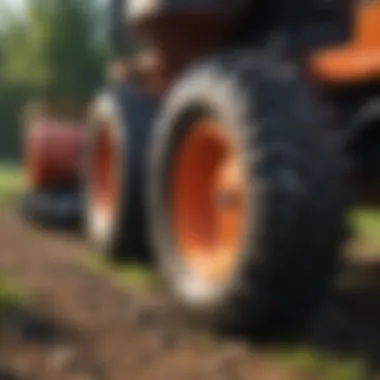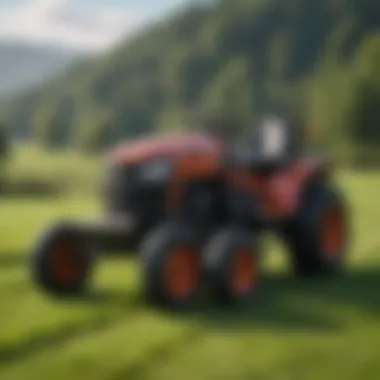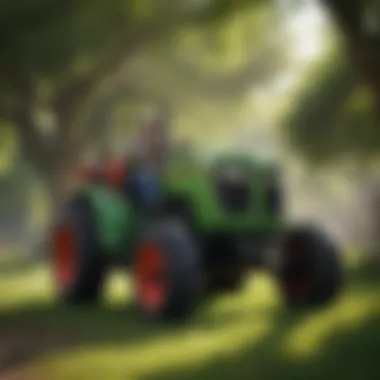Best Lawn Tractors for Steep Hills: A Comprehensive Guide


Intro
Choosing the right lawn tractor for hilly terrain demands careful consideration. Many homeowners face challenges with slopes and steep inclines while maintaining their landscapes. A suitable lawn tractor can enhance efficiency, safety, and overall mowing quality. Understanding the unique demands presented by steep hills is essential for making an informed purchase.
This article aims to provide a thorough guide on selecting the optimal lawn tractor, ensuring that your investment is both practical and effective for challenging landscapes.
Overview of the Topic
Definition and Importance
A lawn tractor is a crucial investment for anyone with a sizable area to maintain. When it comes to steep hills, the right equipment not only makes the job easier but also enhances safety for the operator. Selecting a tractor designed for steep inclines involves understanding various features that contribute to stability and cutting efficiency.
Focusing on appropriate specifications matters. Factors like traction, weight distribution, and cutting deck size influence performance on slopes.
Current Trends
The market for lawn tractors is continuously evolving, with modern models offering advanced features that cater specifically to hilly terrains. Innovations such as improved engines, automated drives, and ergonomic designs are becoming more common. Enthusiasts are increasingly leaning toward greener options like electric lawn tractors, which offer reduced emissions and noise.
Key Techniques and Practices
Step-by-Step Guide
- Assess Your Landscape: Before selecting a lawn tractor, evaluate the steepness of your terrain. Understanding the degree of incline helps determine the necessary horsepower and grip needed to handle slopes.
- Research Models: Investigate different models available in the market. Look for those specifically designed for steep hills, analyzing user reviews and expert opinions.
- Check Specifications: Focus on traction control, cutting height adjustments, and center of gravity. These factors influence your tractor's performance on inclines.
- Seek Demonstrations: If possible, test drive different models. Pay attention to how they maneuver on steep inclines and observe ease of operation.
- Consider Long-Term Needs: Think about future projects or landscaping needs. Investing in a powerful tractor today may save frustration down the line.
Tools and Equipment Needed
Beyond the tractor itself, multiple tools aid in maintaining steep slopes effectively:
- Safety Gear: Helmets and sturdy boots can prevent injuries.
- Rakes and Hoe: For tackling debris and overgrowth.
- Edging Tools: To maintain clean lines along slopes.
Challenges and Solutions
Common Obstacles
Steep hills present specific challenges that require tailored solutions:
- Loss of traction: A common problem resulting in slipping or rolling backward.
- Uneven cutting: Lawnmowers may leave uncut patches or damage the lawn.
- Safety risks: Operating heavy machinery on inclined terrain can lead to accidents.
Innovative Solutions
The right technologies can help mitigate these challenges. Look for tractors equipped with:
- Four-wheel drive: Provides better traction on hills.
- Low center of gravity designs: Enhances stability to prevent tipping.
- Variable speed control: Allows for careful maneuvering on difficult terrain.
"Investing in a tractor with the appropriate specifications not only boosts efficiency but ensures safety while maintaining challenging landscapes."
Culmination
Selecting the right lawn tractor for steep hills entails understanding the unique requirements presented by your landscape. This article aims to empower you with the knowledge needed to make an informed decision. Through this guide, you can navigate the complexities of choosing a tractor that will serve you well for years to come.
Understanding Steep Hills and Their Challenges
Understanding the challenges presented by steep hills is crucial for selecting the right lawn tractor. The maintenance of sloped areas requires specialized equipment that can handle unique terrain difficulties. Steep inclines can lead to issues such as soil erosion and water runoff, complicating landscaping efforts. Therefore, recognizing these challenges helps in making informed decisions when it comes to machinery selection, ultimately ensuring a healthier and more manageable lawn.


Impact of Slope on Lawn Maintenance
The slope of your lawn significantly influences the methods and equipment used for maintenance. When dealing with steep hills, traditional mowers may struggle or even fail to perform effectively. Grass may grow unevenly, and over time, mowing can become a difficult task.
Moreover, steep inclines increase the likelihood of soil compaction in areas where heavy equipment operates. This compaction can hinder grass growth and affect overall lawn health. Choosing a tractor designed for such terrain mitigates these risks and supports better lawn upkeep. Factors such as cutting width, maneuverability, and engine power must be evaluated to cater to the specific challenges that steep slopes present.
Safety Risks Associated with Mowing on Inclines
Mowing on steep hills also introduces significant safety concerns that must not be overlooked. The risk of losing control of the tractor increases sharply on slopes, presenting a potential hazard for the operator. Rollovers are a serious threat, particularly if the mower lacks adequate traction or stability features.
Operators should be aware of the following safety measures:
- Always mow across the slope rather than up and down.
- Use a tractor with a low center of gravity for improved stability.
- Ensure the mower is equipped with features such as anti-slip tires and parking brakes.
The correct choice of lawn tractor enhances both productivity and safety during mowing operations. Understanding the specific challenges posed by steep terrain ensures that users can maintain their lawns effectively and safely.
Key Features to Look for in Lawn Tractors
Selecting a lawn tractor, especially for steep hills, requires understanding specific features that can enhance performance and safety. Not all tractors are built the same. The design, power, and technology differences can greatly influence how well a lawn tractor performs on slopes. Thus, it is crucial to consider several fundamental attributes when making a choice.
Engine Power and Torque Considerations
The engine is the heart of any lawn tractor, and in hilly areas, this becomes even more crucial. A tractor with sufficient engine power helps maintain speed and maneuverability on inclines. Torque is also an important aspect. High torque gives the tractor the ability to power through challenging terrains without losing performance. When evaluating engines, it is wise to look for a minimum horsepower of 20-25 for steep applications. Also, four-stroke engines are often preferred due to their efficiency and smoother operation.
Transmission Types Suitable for Slopes
Transmission plays a vital role in how well a lawn tractor can handle hills. There are mainly two types to consider: gear-driven and Hydrostatic transmissions. Gear-driven systems require manual shifting, offering control but may become complicated on steep surfaces. Hydrostatic transmissions, on the other hand, provide stepless speed adjustments and are generally easier to operate. They deliver smoother power transitions and help maintain traction on inclines. Choosing the right transmission type influences control, especially during turns on slopes.
Mower Deck Design and Size
The design and size of the mower deck directly impact mowing efficiency in hilly environments. A wider deck can cover more area in fewer passes, but may not be the best option for narrow or uneven paths. Additionally, a deck that can be adjusted in height helps avoid scalping, which is vital for maintaining a healthy lawn. The shape matters too; a deep-deck design helps prevent clumping of grass while mowing, ensuring even grass cutting across uneven surfaces. Look for a deck between 42 to 54 inches for effective cuts on steep terrains without compromising on clipping performance.
Traction and Stability Features
When operating a lawn tractor on slopes, traction and stability are key features to consider. Features such as wider tires and low centers of gravity provide better grip and reduce the likelihood of rolling. Additionally, some models include four-wheel drive, which enhances traction on steep and uneven landscapes. Stabilizers, suspension systems, and weight distribution also improve stability during mowing. These features are not to be taken lightly, as they can prevent accidents and ensure safe operation.
"Choosing the right lawn tractor is not just about cutting grass; it is about ensuring safety and effectiveness on challenging terrains."
Top Lawn Tractors for Steep Hills
Choosing the right lawn tractor for steep hills is crucial for effective landscaping and maintenance. Steep inclines bring unique challenges that require specialized machinery. A suitable lawn tractor can handle inclines without compromising safety or performance. The right model ensures not only the efficient cutting of grass but also the long-term health of your lawn. Moreover, investing in a proper lawn tractor can save time and minimize physical strain.
When selecting from various models, it’s essential to examine specific elements that make a tractor optimal for steep hills. These include engine specifications, traction capabilities, and overall stability. Each of these features directly impacts how well the tractor performs on uneven ground. Benefits of choosing the right model can include improved cutting ability, enhanced maneuverability, and increased operator safety.
Model Overview: XYZ Lawn Tractor
Engine Specifications
The XYZ Lawn Tractor comes equipped with a powerful engine that provides the necessary torque for climbing steep hills. Engine specifications are significant because they determine how effectively a tractor can manage challenging terrain. With a robust 24-horsepower engine, this model ensures that users have adequate power to navigate even the steepest slopes comfortably. One of its key characteristics is the liquid-cooled design, which enhances performance by regulating engine temperature during strenuous tasks. This feature is beneficial as it reduces the risk of overheating, extending the life of the engine.
Performance on Slopes
Performance on slopes is another critical factor for assessing a lawn tractor. The XYZ model's increased traction capability allows for better control on inclines. Its heavy-duty tires are designed specifically for gripping uneven surfaces, which minimizes the chance of slipping. This tractor's remarkable claw-like tread enhances stability, making it a popular choice in this article for dealing with steep hills. However, it is worth noting that the overall maneuverability might decrease if turning sharply on very steep angles.
User Reviews


User reviews often provide valuable insights into the real-world performance of lawn tractors. The XYZ Lawn Tractor has garnered positive feedback for its reliable starting capabilities and ease of use. Many reviews highlight the straightforward controls, which make it suitable for both seasoned users and first-time owners. Additionally, some users mention that its durability is a strong selling point, holding up well even in tough mowing conditions. The unique feature that stands out in reviews is the tractor's comfortable seating and ergonomic design, allowing users to maintain effort for extended periods without fatigue.
Model Overview: ABC Ride-On Mower
Engine Specifications
The ABC Ride-On Mower is renowned for its innovative engine design. A key highlight is its eco-friendly operation, featuring a 20-horsepower engine that uses less fuel compared to traditional models. Fuel efficiency is vital, especially for users maintaining large areas of steep terrain. The reduction in fuel consumption not only lowers operating costs but also prolongs cutting sessions without frequent refueling. However, it’s important to note that while it is efficient, its lower horsepower may affect speed during mowing on steep inclines compared to heavier models.
Performance on Slopes
When it comes to performance on inclines, the ABC Ride-On Mower excels with its low center of gravity. This design offers better stability when traversing hills. Reviewers report that it handles slopes effectively and retains control even on challenging terrains. The mower also features adjustable speed settings, allowing operators to adapt their pace depending on the grass condition. Nevertheless, some users have pointed out that it can bog down in overly thick grass, indicating a limitation with power during tough cutting conditions on steep edges.
User Reviews
User reviews for the ABC Ride-On Mower highlight its ease of operation and safety features. Many appreciate the design of its seat, which is built to prevent slipping during sharp turns. Customers often praise the quiet operation of the engine, making mowing a less intrusive activity. However, some reviews indicate that for steep hills, it may not be the go-to choice for those needing more robust performance. Despite this, the uniqueness of its ease of maintenance stands out positively among owners.
Model Overview: DEF Zero-Turn Tractor
Engine Specifications
The DEF Zero-Turn Tractor stands out due to its high-performance engine, which boasts a 30-horsepower rating. This specification is critical as it allows for quick acceleration and formidable power when navigating steep terrains. Users appreciate the tractor's quick-shifting capabilities, enabling a smooth transition between different mowing tasks. However, the power produced also requires careful handling on steep slopes, which may pose a slight risk if not managed correctly.
Performance on Slopes
Performance on slopes for the DEF model is significantly enhanced by its zero-turn feature. This allows operators to make tight turns without leaving behind uncut grass. Its design adds to user safety, as it reduces the risk of tipping over on inclines. The tractor's superior balance and weight distribution help in maintaining traction on hilly surfaces. Some downsides include the learning curve required to operate efficiently, which may not suit all users, especially those unfamiliar with zero-turn technology.
User Reviews
User reviews for the DEF Zero-Turn Tractor reflect satisfaction regarding both power and efficiency. Many users have remarked on how quickly they can cover ground and how effectively the mower can handle tough spots. The unique feature frequently mentioned is the tractor's durability under extreme conditions. However, a few users mention that higher maintenance costs can be a downside, impacting overall value for long-term users. Nevertheless, its reputation persists in being highly regarded amongst serious lawn enthusiasts.
Comparative Analysis of Features
When choosing a lawn tractor for navigating steep hills, understanding the comparative analysis of features is critical. This section helps buyers comprehend the essential aspects of various tractor models. A well-rounded analysis allows for informed decisions, maximizing efficiency while minimizing risks associated with hilly terrains.
Performance Metrics
Performance metrics are fundamental when evaluating lawn tractors for steep inclines. They encompass various factors ranging from engine power, torque, to maneuverability. For steep hills, it is not just raw power that matters; a tractor's agility on inclines significantly affects its usability.
- Engine Power: A stronger engine means higher performance. It allows the tractor to overcome gravitational pulls effectively.
- Torque: High torque is necessary for maintaining speed on slopes. It directly contributes to how well a tractor can manage tough terrain conditions.
- Speed: The ability to adjust speed while mowing helps to control the cutting quality and safety precautions effectively.
Evaluating models based on these metrics can narrow down options that suit specific landscaping needs.
Cost-Effectiveness and Value
Cost-effectiveness is another vital aspect of comparative analysis. While a lower price might be attractive, the long-term value must be considered. Investing in a robust lawn tractor can yield benefits such as durability and efficiency.
- Upfront Costs vs. Long-term Maintenance: Compare initial purchase prices with predicted maintenance costs over time. Some tractors might have a higher upfront cost but lower maintenance expenses.
- Fuel Efficiency: Tractors that consume less fuel save money and are more environmentally friendly. Assessing fuel consumption relative to performance can impact overall value significantly.
- Resale Value: Consider how well a tractor holds its value over time. Models from reputable manufacturers often have better resale ratings.
Understanding these factors will help potential buyers assess which lawn tractors provide optimal value for their specific conditions.
User Satisfaction Ratings
User satisfaction ratings serve as a crucial indicator of a lawn tractor's real-world performance. They provide insights from fellow stewards who have firsthand experience with the tractors on steep hills.


- Review Platforms: Look for models with high ratings on user-review platforms. Websites like Reddit and gardening forums can provide varied perspectives.
- Common Feedback Themes: Pay attention to consistent praise or complaints regarding stability, ease of use, and maintenance. Feedback about handling steep inclines can be particularly telling.
- Warranty Information: A good warranty may reflect the manufacturer's confidence in their product's performance, contributing to user satisfaction.
Maintenance Tips for Lawn Tractors on Hills
Maintaining lawn tractors on steep hills is crucial for ensuring performance and longevity. Steep terrains present unique challenges, making regular upkeep not just beneficial but essential. Proper maintenance helps prevent mechanical failures and enhances safety during operation. Here, we provide a comprehensive overview of the key maintenance tips specifically tailored to lawn tractors used in hilly environments.
Routine Maintenance Checklist
A proactive approach to routine maintenance can greatly extend the life of your lawn tractor. Here is a checklist to keep in mind:
- Inspect the Engine: Regularly check the oil level, air filters, and spark plugs. Change oil every 50 hours of operation or as recommended by the manufacturer.
- Clean the Mower Deck: Remove grass clippings and debris that can accumulate on the deck. This prevents rust and ensures efficient mowing.
- Check Bolts and Fasteners: Periodic inspections of all bolts and fasteners ensure nothing is loose, especially after mowing on inclines.
- Sharpen Blades: Keeping blades sharp is essential for a clean cut and reduces the strain on the engine.
- Inspect the Battery: Check battery connections and clean off corrosion. Ensure that the battery is secure and holds a charge properly.
Adjusting Mower Deck Height
Setting the mower deck to the correct height for steep areas is important. A lower deck may cause scalping on high points, while a too-high setting could leave uncut grass in depressions. Here’s how to adjust the mower deck height:
- Determine Optimal Height: Research the type of grass in your lawn to find the recommended cutting height.
- Use Lever or Mechanism: Most lawn tractors come with a lever or dial to adjust the mower deck. Set it to the appropriate height based on your grass type.
- Test Before Full Operation: Run the tractor in a small section to determine if adjustments are necessary before mowing the entire area.
Tire Maintenance and Replacement
Proper tire maintenance is critical, especially on steep hills where traction can be compromised. Here’s how to ensure your tires are in shape:
- Check Tire Pressure: Maintain the recommended tire pressure. Insufficient pressure reduces traction, while over-inflated tires can cause instability.
- Inspect Tread Wear: Look for uneven wear that may indicate alignment issues or incorrect pressure.
- Replace Tires When Necessary: If the tread is worn down to a certain level, replacements should be considered. Look for tires specifically designed for steep terrain.
Good maintenance practices can enhance the functionality of your lawn tractor while operating on hills. Neglecting these simple yet critical aspects can lead to costly repairs and unwanted accidents.
Practical Usage Guidelines
Understanding how to effectively operate a lawn tractor on steep hills is crucial for both safety and efficiency. This section provides vital insights into best practices, ensuring that users can navigate challenging terrains without risking their equipment or wellbeing. Properly following usage guidelines not only extends the life of the tractor but also maximizes mowing results, leading to a healthier lawn.
Safe Operating Practices on Inclines
When mowing on inclines, adherence to safety practices cannot be overstated. Understanding the terrain dynamics is one of the first considerations.
- Assessment of the Slope: Before starting, it's essential to assess the slope's steepness. Many manufacturers categorize their tractors based on the degree of slope they can handle. A steep slope can pose different risks—wheels may lose traction, or the mower may roll, resulting in accidents.
- Weight Distribution: Ensure weight is evenly distributed on the lawn tractor. Moving heavy items like bags of soil can ensure stability while mowing. It's also advisable to keep the mower deck high to avoid excessive drag on slopes.
- Operating Direction: Mowing up and down the slope rather than across is safer. This strategy helps maintain better control. Always be aware of the tractor's position to reduce the chances of rollovers.
- Maintain Slow Speeds: Slow and steady is paramount on inclines. This allows for better control and reaction time in case of unforeseen movement.
- Check Tire Condition: Tires should be in good condition, as worn or damaged tires can lead to loss of traction. Adjust tire pressure according to the manufacturer's recommendation for optimal grip.
Best Techniques for Mowing Steep Areas
Mowing steep areas requires strategies tailored to the challenges these terrains present. Here are some of the most effective techniques:
- Create a Pattern: Developing a mowing pattern is essential. Create lines that follow the slope to ensure each pass is efficient. This can help you avoid missing patches.
- Frequent Adjustments: Do not shy away from stopping regularly to adjust the mowing height. Ensure the cutting height matches the grass type and growth conditions. Lifting the mower deck can prevent scalping the grass.
- Use of Mulching Feature: If your lawn tractor has a mulching feature, utilize it. This technique not only recycles grass clippings but can also promote soil health.
- Plan Around Weather Conditions: Timing your mowing can make a significant difference. Soil may become slippery after rain, increasing the possibility of accidents. Assess weather conditions before mowing.
- Avoid Mowing Wet Grass: Wet grass can be hazardous, leading to slips or loss of control. It is better to mow during drier periods to provide a safer and cleaner cut.
The End and Recommendations
Selecting the right lawn tractor for steep hills is crucial for ensuring effective lawn maintenance and safety. This choice directly impacts not only the quality of the lawn care but also the longevity and reliability of the equipment. As outlined in the previous sections, the unique challenges presented by hilly terrain necessitate specific features in a lawn tractor. Buyers need to consider engine power, torque, stability, and design elements when making their selection.
Summary of Findings
In summary, several important aspects have been highlighted throughout this article:
- Engine Power: A powerful engine with adequate torque is essential for maneuvering on steep slopes.
- Transmission Types: Hydrostatic transmissions often provide smoother operation and better control on inclines compared to gear-driven systems.
- Deck Design: A properly designed mower deck can enhance cutting efficiency and prevent scalping, an issue prominent on uneven surfaces.
- Traction Features: Features such as larger tires and advanced traction control systems help improve stability and minimize the risk of slipping on slopes.
The examined models such as the XYZ Lawn Tractor and DEF Zero-Turn Tractor illustrate the range of options available to buyers while catering to the need for robustness and versatility in performance.
Final Recommendations for Buyers
For buyers looking to invest in a lawn tractor suitable for steep hills, consider the following recommendations:
- Assess Your Landscape Needs: Consider the specific slopes and terrain you will be working with. Measure steepness and types of grass for optimal performance.
- Select Based on Features: Ensure that the tractor you choose has strong engine specifications, suitable transmission, and excellent stability features. Compare flow rates and engine output among models.
- Read User Reviews: User feedback can provide invaluable insights into real-world performance. Check platforms such as Reddit and Facebook for community opinions.
- Prioritize Safety: Look for models equipped with safety features such as rollover protection systems (ROPS) to mitigate risks when operating on sloped surfaces.
- Budget Consideration: Balance features against price. A higher upfront cost might be justified by long-term performance and durability.
In closing, selecting the ideal lawn tractor for steep hills can be a challenging task. However, armed with the right knowledge and recommendations, buyers can find a model that meets their specific needs and enhances their landscaping endeavors.



